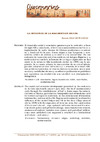Identificador persistente para citar o vincular este elemento:
https://accedacris.ulpgc.es/jspui/handle/10553/59954
| Campo DC | Valor | idioma |
|---|---|---|
| dc.contributor.author | Díaz Hernández, Ramón Faustino | en_US |
| dc.date.accessioned | 2019-12-19T20:12:38Z | - |
| dc.date.available | 2019-12-19T20:12:38Z | - |
| dc.date.issued | 2019 | en_US |
| dc.identifier.issn | 2695-4494 | en_US |
| dc.identifier.uri | https://accedacris.ulpgc.es/handle/10553/59954 | - |
| dc.description.abstract | El desarrollo social y económico generado por la cochinilla a fines del siglo XIX y, más tarde, el breve ciclo sacarocrático a través de la implantación de media docena de fábricas productoras de azúcar en la localidad de Arucas, dieron origen a una burguesía y «neonobleza» ávidas de cultura y de abrirse a la modernidad. En ese ambiente de transición entre los residuos del Antiguo Régimen y la modernidad es donde la influencia de las logias capitalinas se dejó sentir en la entonces villa (nombrada ciudad en 1894) con la ampliación de su casco urbano, la construcción de su actual iglesia, grandes infraestructuras hidráulicas y la erección de nuevos edificios públicos y privados; se crearon bandas de música, se abrieron casinos y sociedades obreras y se editaron publicaciones periódicas que supusieron un revulsivo en una sociedad rural jerarquizada y endogámica. | en_US |
| dc.description.abstract | The social and economic development generated by the cochinilla in the late nineteenth century and, later, the brief saccharocratic cycle through the establishment of half a dozen sugar factories in the town of Arucas, gave rise to a bourgeoisie and «neonobleza» avid for culture and open to modernity. In this environment of transition between the residues of the Old Regime and modernity is where the influence of the capital lodges was felt in the then village (named city in 1894) with the expansion of its urban area, the construction of its current church, large hydraulic infrastructures and the erection of new public and private buildings; music bands were created, casinos and workers' societies were opened and periodical publications were published that supposed a revulsive in a hierarchical and inbred rural society. | en_US |
| dc.language | spa | en_US |
| dc.relation.ispartof | Cliocanarias | en_US |
| dc.source | Cliocanarias [ISSN 2695-4494), n. 1, p. 69-88 | en_US |
| dc.subject | 550301 Historia local | en_US |
| dc.subject.other | Masonería | en_US |
| dc.subject.other | Freemasonry | en_US |
| dc.subject.other | Logias masónicas | en_US |
| dc.subject.other | Taller | en_US |
| dc.subject.other | Sociedades | en_US |
| dc.subject.other | Modernización | en_US |
| dc.subject.other | Masonic lodges | en_US |
| dc.subject.other | Workshop | en_US |
| dc.subject.other | Societies | en_US |
| dc.subject.other | Modernization | en_US |
| dc.title | Influencia de la masonería en Arucas | en_US |
| dc.type | info:eu-repo/semantics/article | en_US |
| dc.type | Article | en_US |
| dc.description.lastpage | 69-88 | en_US |
| dc.investigacion | Artes y Humanidades | en_US |
| dc.type2 | Artículo | en_US |
| dc.utils.revision | Sí | en_US |
| dc.identifier.ulpgc | Sí | en_US |
| dc.contributor.buulpgc | BU-HUM | en_US |
| item.grantfulltext | open | - |
| item.fulltext | Con texto completo | - |
| crisitem.author.dept | GIR IATEXT: Sociedades y Espacios Atlánticos | - |
| crisitem.author.dept | IU de Análisis y Aplicaciones Textuales | - |
| crisitem.author.orcid | 0000-0003-1338-9046 | - |
| crisitem.author.parentorg | IU de Análisis y Aplicaciones Textuales | - |
| crisitem.author.fullName | Díaz Hernández, Ramón | - |
| Colección: | Artículos | |
Visitas
309
actualizado el 28-ago-2021
Descargas
54
actualizado el 28-ago-2021
Google ScholarTM
Verifica
Comparte
Exporta metadatos
Los elementos en ULPGC accedaCRIS están protegidos por derechos de autor con todos los derechos reservados, a menos que se indique lo contrario.
